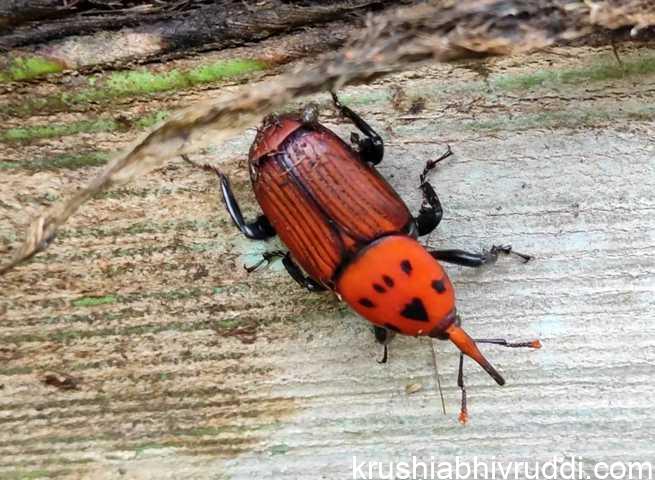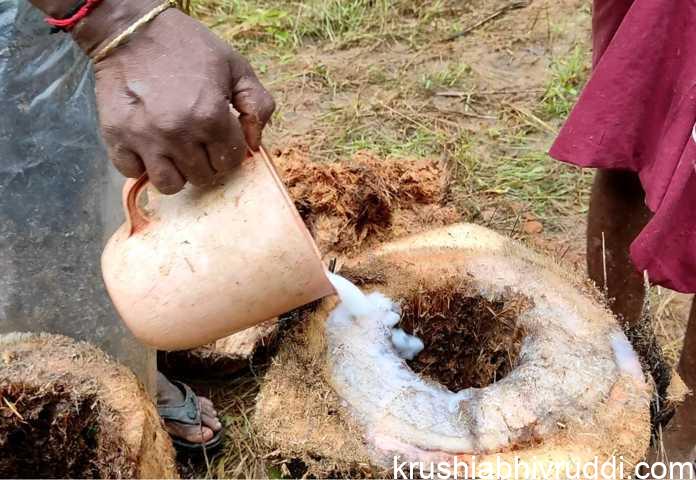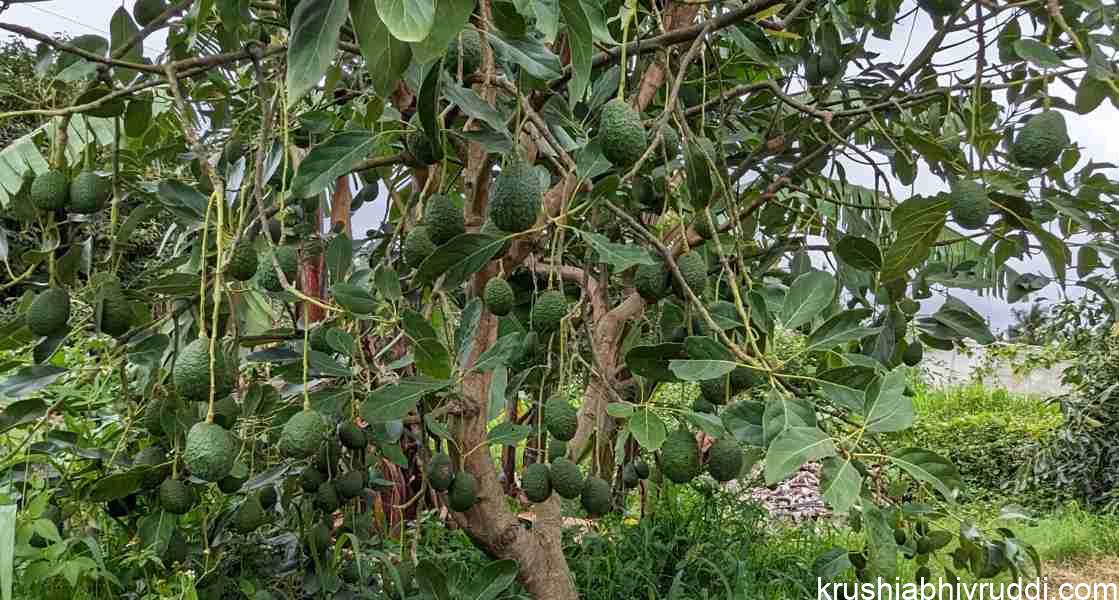Now coconut palm is highly threatened by a pest called red palm weevil. If it is attached to the tree, the chances of survival are very less. Coconut palm is a universal crop grown as a plantation crop and also a home garden plant. In south Indian states coconut is grown on a large scale. Here this plant is having spiritual importance also. It requires 5-6 years to start yielding. Its life span is more than 50 years. In this period if any disease or pest attack occurred, the farmer lost the whole tree. Now the coconut palm is highly affected by bud rot and Red palm weevil attack. Both are more dangerous problems in coconut cultivation. Bud can be cured if it is identified early. But pest like Red palm weevil fatally damages the tree. Farmers lost several trees and plants because of these pests and diseases. Here we show how to identify the pest attack on coconut palm and how to control it.
Last few days back I went to my garden and observed a coconut palm leaf turning pale yellowish. Initially, my concentration was on the bud rot. Observed the bud section and was satisfied it is perfect. Without any problem, it will not happen. So I observed the trunk part and identified some damage at the trunk part. I put a knife into the hole in the trunk and it was too deep. Immediately I confirmed it is the damage of the Red palm weevil. I started to cut the damaged portion to find out how much damage happened. When cutting the trunk part we observe the damage is serious. Here we can find the rotted fibers of the coconut tree which is damaged by this weevil.

The red palm weevil is the most dangerous pest of the coconut palm. It is found in almost all coconut-growing countries. We are well-known about the Rhinocerous beetle which damages the leaf and unopened inflorescence of the palm. But red palm weevil damage is different from this beetle. Here main damage is caused by grubs. The grub completes its life cycle inside the palm, feeding the soft tissues of the palm. The female weevil searched for any damaged part on the trunk nearby the crown. It enters into the trunk part and lays eggs. Here this tree is damaged seriously by this pest. We find there are no chances of survival. So we decided to cut the tree. When we cut the tree it is easy to kill all weevils and grubs hidden inside the tree. If any serious damage happened, farmers must do this. If we leave this tree to die itself the multiplication of pests increases and it will damage other healthy plants also. Cutting trees and treating them with poison or burning them is the only solution for suppressing the pest population.
The life cycle of pest:
Female Red palm weevils lay around 300 numbers of eggs inside the tree trunk. The egg will be hatched in 3-5 days. The grubs live up to 60-70 days, sucking the sap. It will go almost all parts of the tree even up to the roots. Sometimes if the root is damaged tree will fall. After this period, it will go to the pupa stage. This period is up to 15 days. Next, it will become a beetle. Within 4-5 days weevil or beetle becomes ready for laying eggs. Host to its life cycle is palm species trees.

Here we are elaborately showing the damage made by the pest. To show this we are cutting part and parts. When we cut vertically, we find damage made to inside the trunk part. The coconut palm has only one terminal bud. The outer part of the trunk is hard and the inside part is fibrous. This pest multiplies inside this fibrous tissue part. We here show its activities inside the trunk.
When we cut the tree we find that the base part is healthy. After cutting the front parts we find the seriousness of pest damage. Inside, soft tissues are completely decayed and an odd smell will appear. One by one piece cutting showed us many weevils and grubs inside the trunk and leaf bottom. Up to the crown part, we cut two feet long. After this, we again cut it into a horizontal shape to show you how the damage has. Cutting the coconut tree is not that much easy. Its outer part is hard and it is made up of a shell type. When cutting we find some weevils coming out from different parts. By tree felling and cutting vibration, they come out from the tree. These weevils are red-colored and have sharp mouthparts. If we catch this, it will bite us also.

When we cut the whole stem we observed a hundred and above grubs and weevils inside the trunk. Also, damage caused by them. This weevil (Female) lay eggs inside the soft part. We observed this pest will also damage semi-soft parts. Even it will attack the bottom stem parts of 2-3-4 year plants also. Many grubs entered the pupa stage. The Pupa nest is like this. These people show you every part of the damage made by this pest.
How do we find this tree will not survive? See the inside tissues of the tree. It is completely damaged. In coconut palm, this part is very important to supply food and water to the leaves. If it is damaged the supply chain will be blocked. Even the bud part was also damaged because of this. So we confirmed this is not suitable to recover.

How to prevent the damage:
It is not an individual effort to control the population. Every farmer can strictly follow the preventive measures. If any tree becomes infected by bud rot after its complete leaf falls everybody should cut the tree and dispose of it in the correct manner like burning or poison treatment. If any tree is damaged by lightning arrest, immediately it should be cut and disposed of. If any palm species of trees die, we should not leave them. Cutting and burning should be done. Do not leave any wood, trunk, or any part of the tree. Its sap attracts the beetle. Do not throw the tender coconuts anywhere. Spread it in the sunlight. Do not throw rotted fruits and bananas. If any areca nut trees are damaged by lightning or bud rot, they should be disposed of immediately. This type of measure should be taken by all farmers. Then its population will be suppressed.

Treatment:
The purpose of cutting a tree is to destroy the pests hidden inside the tree parts. Pick all visible grubs and beetles when cutting and splitting the trunk parts. Then keep all cut parts horizontally in any nearby place. Prepare the pesticide solution to soak the cut parts. Chloropheriphos, a pesticide is suitable for killing larvae and beetles. It is easily available in almost all places. Make the solution by adding 5 ml of pesticide in 1 liter of water and prepare the solution up to ten liters. If the Tree is big make more solutions. Soak all the parts by putting pesticide solution in a mug. Not only for cut parts but also all chewed fibers deposited nearby the tree.

In addition to Chloropheriphos pesticide, as a preventive measure, put some Phorate 10g granules in all the cut parts. Also, drench the pesticide where the tree has been cut. In this part, some sap will be oozed for some days. It is a normal process. The smell of this sap will attract the female beetle. To prevent this drenching is important. During summer it is very best to burn the parts. It is harmless and very effective.
Protection of coconut palms from this pest is very important because if we neglect this it will damage more trees. All palm spices are host to this and coconut is the major. Soft or dwarf varieties like Orange, Green, and yellow dwarfs are highly affected by this pest. Regular Inspection and chemical treatment are the preventive measures.











